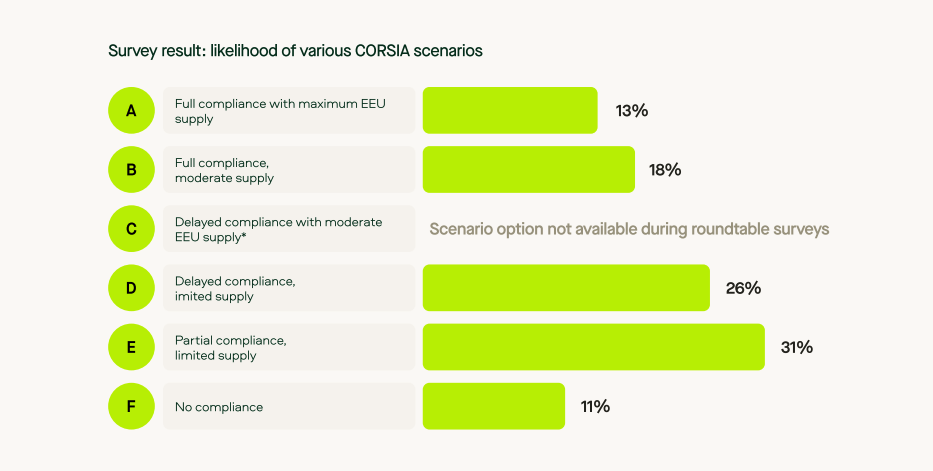“Over the years we’ve invested significantly in our field data team - focusing on producing trusted ratings. While this ensures the accuracy of our Ratings, it doesn’t allow the scale across the thousands of projects that buyers are considering.”
For more information on carbon credit procurement trends, read our "Key Takeaways for 2025" article. We share five, data-backed tips to improve your procurement strategy.

One more thing: Connect to Supply customers also get access to the rest of Sylvera's tools. That means you can easily see project ratings and evaluate an individual project's strengths, procure quality carbon credits, and even monitor project activity (particularly if you’ve invested at the pre-issuance stage.)
Book a free demo of Sylvera to see our platform's procurement and reporting features in action.
As CORSIA's January 2028 First Phase compliance deadline approaches, the aviation industry faces unprecedented uncertainty about how the world's first global carbon offsetting program will actually unfold. Will airlines collectively purchase 144 million carbon credits? Will only major jurisdictions enforce compliance? Could the entire program collapse?
To answer these questions, our industry-first market modeling has identified six distinct scenarios for CORSIA implementation, each with radically different implications for airlines, carbon markets, and climate policy. These scenarios are grounded in expert analysis of supply constraints, regulatory realities, and market dynamics.
A survey of 40+ industry experts — including CORSIA Technical Advisory Body members, carbon market professionals, and policy specialists — reveals which outcomes they consider most probable. The results challenge many assumptions about CORSIA's trajectory and highlight the critical uncertainties that will determine the program's ultimate impact.

What are the potential scenarios of CORSIA Phase 1?
Scenario A: Full Compliance, maximum supply (13% expert probability)
In this best-case scenario, over 30 countries develop Article 6 authorization capacity by 2027, enabling broad carbon credit exports with corresponding adjustments. Large volumes from jurisdictional REDD+ programs and the Paris Agreement Crediting Mechanism (PACM) flood the market, creating 274 million EEUs available by late 2027—nearly double the 144 million needed for full compliance.
Key assumptions:
- All major aviation jurisdictions enforce CORSIA through regulation or voluntary compliance
- Rapid development of host country authorization frameworks
- Significant supply from JREDD+ programs (100+ million credits)
- PACM becomes operational and ICAO-approved
Price implications: Abundant supply keeps prices moderate around $25 per EEU by 2027, with minimal price spikes as airlines secure compliance well ahead of deadlines.
Reality check: Only 13% of experts consider this scenario likely, reflecting skepticism about rapid institutional development and coordinated global implementation.
Scenario B: Full compliance, moderate supply (18% expert probability)
This scenario assumes similar demand as Scenario A but under more restrictive supply conditions. Only 15 countries develop authorization capacity, and JREDD+/PACM volumes remain limited, resulting in 191 million EEUs by 2027—still adequate for full compliance but with tighter margins.
Market dynamics: Prices reach $36 per EEU by 2027 as airlines compete for scarcer credits. The compliance market functions but with notable price volatility as deadlines approach.
Strategic implication: Airlines face 40% higher costs than Scenario A, making early procurement and hedging strategies critical for cost management.
Scenario C: Delayed compliance, moderate supply (Note: scenario not surveyes)
Recognizing supply shortages, ICAO delays the First Phase compliance deadline from January 2028 to January 2030. This provides additional time for host country authorization development and credit issuance, ultimately enabling full compliance under less pressure.
Critical assumption: The delay must be announced with clear commitment to eventual implementation, maintaining market confidence and supply development incentives.
Price impact: Immediate price relief in 2027-2028 as deadline pressure eases, followed by gradual increases approaching the delayed deadline.
Scenario D: Delayed compliance, limited supply (26% expert probability)
Even with timeline extension, host country readiness remains constrained to just 7 countries providing authorizations between 2025-2026. Supply reaches only 144 million EEUs by the delayed deadline — barely meeting demand under intense price pressure.
Price trajectory: Rapid near-term price increases to $60+ per EEU as scarcity becomes apparent, followed by temporary moderation after delay announcement, then renewed spikes approaching the new deadline.
Market stress: This scenario creates the highest price volatility and greatest compliance cost uncertainty for airlines.
Scenario E: Partial compliance, limited supply (31% expert probability, the ‘most likely’ outcome)
Expert consensus identifies this as the most probable scenario. Only major aviation jurisdictions — EU, UK, Switzerland, Japan, Canada, UAE, and Qatar—enforce CORSIA compliance, effectively halving demand to 74 million EEUs. Combined with limited supply (136 million EEUs), this creates a functioning but reduced-scale market.
Why experts favor this: Reflects realistic assessment of:
- Limited regulatory enforcement globally
- Constrained host country authorization capacity
- Airlines' tendency toward voluntary compliance in key markets
- Political economy challenges in smaller jurisdictions
Implications: CORSIA becomes a regional rather than global program, with significant implications for competitive dynamics between complying and non-complying airlines.
Scenario F: No Compliance (11% expert probability)
Supply bottlenecks and regulatory uncertainty combine to undermine market confidence entirely by 2027. Airlines abandon compliance planning, host countries stop authorization processes, and CORSIA dissolves as a functional program.
Cascade effects: Credits originally destined for CORSIA flood voluntary markets, potentially crashing prices. The failure undermines confidence in aviation climate policy generally.
Concerining probability: That 11% of experts consider this scenario plausible reflects genuine concerns about CORSIA's structural vulnerabilities.
.png)
What the CORSIA expert consensus reveals
Limited supply dominates expectations
Combining scenarios D and E, 57% of experts expect limited supply conditions — reflecting widespread skepticism about host country authorization development. This suggests the "chicken-and-egg" problem of authorization readiness may prove intractable in CORSIA's tight timeline.
Full compliance skepticism
Only 31% of experts expect full compliance (scenarios A and B combined), with most anticipating either partial compliance or delayed implementation. This highlights concerns about regulatory enforcement capacity globally.
Extreme outcomes unlikely
The extreme scenarios — maximum supply success (13%) and complete collapse (11%) — receive similar low probabilities, suggesting experts expect muddle-through outcomes rather than dramatic success or failure.
Strategic implications by likely CORSIA scenarios
For airlines: Scenario-based planning
High-probability scenarios (D + E = 57%): Both feature limited supply, suggesting airlines should:
- Budget for higher-than-expected credit costs ($40-60+ per EEU)
- Prioritize early supplier relationships in the 16 ready countries
- Develop contingency plans for partial enforcement environments
Compliance strategy: Even under partial compliance scenarios, competitive pressure may drive voluntary compliance beyond regulatory requirements.
For carbon markets: Supply development urgency
Authorization acceleration: The dominance of limited supply scenarios highlights the critical need for host country authorization development. Countries showing readiness could see major economic benefits.
Investment timing: Project developers should prioritize jurisdictions with higher authorization probability rather than maximum project potential.
For policymakers: Implementation support
Regulatory clarity: The 26% probability of delayed compliance suggests early regulatory signals about enforcement could prevent timeline disruptions.
International cooperation: Supporting developing countries' Article 6 implementation could shift probabilities toward higher-supply scenarios.
The CORSIA scenarios as market signals
These scenarios can act as market pricing signals within the current carbon credit valuations and airline planning assumptions. Understanding which scenarios market participants consider most likely helps explain:
- Current price premiums for CORSIA-eligible credits over voluntary market equivalents
- Airline hesitancy to commit to large-scale credit purchases without supply certainty
- Project developer focus on authorization-ready countries rather than maximum-potential markets
- Financial sector reluctance to provide large-scale CORSIA-specific products
Timeline for CORSIA Phase 1 resolution
2025: Host country authorization announcements will eliminate some scenarios and raise probabilities of others
2026: EU CORSIA review and national enforcement decisions will clarify demand-side scenarios
Early 2027: Airline procurement behavior will reveal actual compliance intentions vs. theoretical requirements
Mid-2027: Supply availability will determine whether delayed compliance becomes necessary
Late 2027: Market pricing will reflect final scenario probabilities as deadline approaches
Monitoring these key indicators will help market participants adjust strategies as scenario probabilities shift.
Access the Complete CORSIA Scenario Analysis
This scenario breakdown draws from Sylvera's comprehensive CORSIA First Phase Scenario Modeling report, featuring detailed market modeling, a survey of 40+ industry experts, and quantitative analysis across all six CORSIA scenarios.
Download the full report for complete scenario modeling results, expert survey data, price projections for each pathway, and strategic recommendations for navigating CORSIA uncertainty.

Helping airlines navigate CORSIA complexity
With deep expertise in both carbon markets and policy, Sylvera provides the critical intelligence and tools needed to succeed in the evolving CORSIA landscape.
Strategic CORSIA compliance & market intelligence
Our policy experts help airlines, investors, and carbon market participants develop robust CORSIA compliance strategies by providing realistic assessments of market scenarios and regulatory developments. We help you navigate uncertainty and position for action before prices rise, ensuring your strategies remain resilient across multiple scenarios.
End-to-end support
From initial discovery through rigorous due diligence to ongoing monitoring, Sylvera supports your complete journey with CORSIA-eligible credits. Our trusted ratings provide deep project-level analysis to assess true quality and risk. With limited supply and intensifying demand for CORSIA-eligible credits, we help you identify high-quality opportunities in this nascent market.
Data-driven decision making
Having reliable data and insights is crucial for informed decision-making. Sylvera's Market Data provides real-time market intelligence, and our in-house scenario modeling helps you take low-risk climate action.
If you need expert guidance in navigating CORSIA, our team is ready to help. Get a free Sylvera demo here.









.png)





